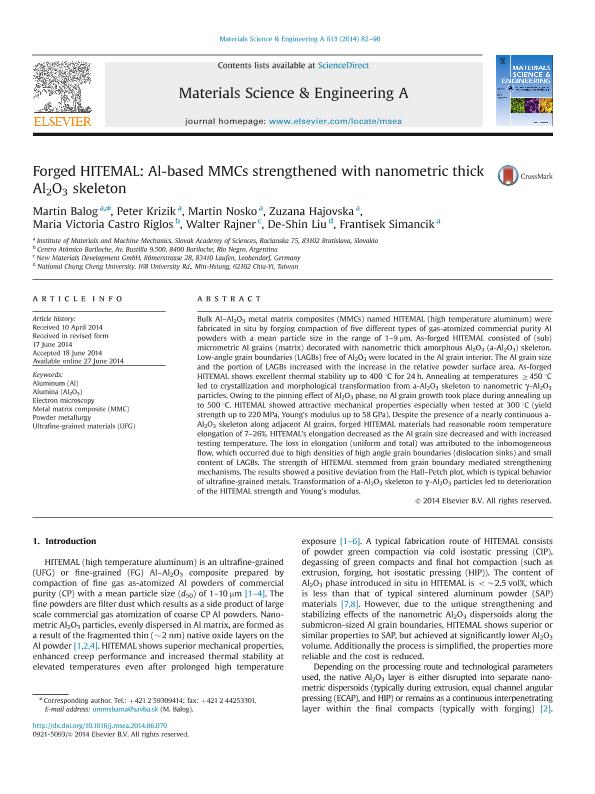Mostrar el registro sencillo del ítem
dc.contributor.author
Balog, Martin
dc.contributor.author
Krizik, Peter
dc.contributor.author
Nosko, Martin
dc.contributor.author
Hajovska, Zuzana
dc.contributor.author
Castro Riglos, Maria Victoria

dc.contributor.author
Rajner, Walter
dc.contributor.author
Liu, De Shin
dc.contributor.author
Simancik, Frantisek
dc.date.available
2022-12-07T14:16:33Z
dc.date.issued
2014-06
dc.identifier.citation
Balog, Martin; Krizik, Peter; Nosko, Martin; Hajovska, Zuzana; Castro Riglos, Maria Victoria; et al.; Forged HITEMAL: Al-based MMCs strengthened with nanometric thick Al2O3 skeleton; Elsevier Science SA; Materials Science and Engineering A: Structural Materials: Properties, Microstructure and Processing; 613; 6-2014; 82-90
dc.identifier.issn
0921-5093
dc.identifier.uri
http://hdl.handle.net/11336/180522
dc.description.abstract
Bulk Al-Al2O3 metal matrix composites (MMCs) named HITEMAL (high temperature aluminum) were fabricated in situ by forging compaction of five different types of gas-atomized commercial purity Al powders with a mean particle size in the range of 1-9μm. As-forged HITEMAL consisted of (sub)micrometric Al grains (matrix) decorated with nanometric thick amorphous Al2O3 (a-Al2O3) skeleton. Low-angle grain boundaries (LAGBs) free of Al2O3 were located in the Al grain interior. The Al grain size and the portion of LAGBs increased with the increase in the relative powder surface area. As-forged HITEMAL shows excellent thermal stability up to 400°C for 24h. Annealing at temperatures ≥450°C led to crystallization and morphological transformation from a-Al2O3 skeleton to nanometric γ-Al2O3 particles. Owing to the pinning effect of Al2O3 phase, no Al grain growth took place during annealing up to 500°C. HITEMAL showed attractive mechanical properties especially when tested at 300°C (yield strength up to 220MPa, Young's modulus up to 58GPa). Despite the presence of a nearly continuous a-Al2O3 skeleton along adjacent Al grains, forged HITEMAL materials had reasonable room temperature elongation of 7-26%. HITEMAL's elongation decreased as the Al grain size decreased and with increased testing temperature. The loss in elongation (uniform and total) was attributed to the inhomogeneous flow, which occurred due to high densities of high angle grain boundaries (dislocation sinks) and small content of LAGBs. The strength of HITEMAL stemmed from grain boundary mediated strengthening mechanisms. The results showed a positive deviation from the Hall-Petch plot, which is typical behavior of ultrafine-grained metals. Transformation of a-Al2O3 skeleton to γ-Al2O3 particles led to deterioration of the HITEMAL strength and Young's modulus.
dc.format
application/pdf
dc.language.iso
eng
dc.publisher
Elsevier Science SA

dc.rights
info:eu-repo/semantics/openAccess
dc.rights.uri
https://creativecommons.org/licenses/by-nc-sa/2.5/ar/
dc.subject
ALUMINUM (AL)
dc.subject
ELECTRON MICROSCOPY
dc.subject
METAL MATRIX COMPOSITE (MMC)
dc.subject
POWDER METALLURGY
dc.subject
ULTRAFINE-GRAINED MATERIALS (UFG)
dc.subject.classification
Ingeniería de los Materiales

dc.subject.classification
Ingeniería de los Materiales

dc.subject.classification
INGENIERÍAS Y TECNOLOGÍAS

dc.title
Forged HITEMAL: Al-based MMCs strengthened with nanometric thick Al2O3 skeleton
dc.type
info:eu-repo/semantics/article
dc.type
info:ar-repo/semantics/artículo
dc.type
info:eu-repo/semantics/publishedVersion
dc.date.updated
2022-12-06T17:16:18Z
dc.journal.volume
613
dc.journal.pagination
82-90
dc.journal.pais
Países Bajos

dc.journal.ciudad
Amsterdam
dc.description.fil
Fil: Balog, Martin. Slovak Academy of Sciences. Institute of Botany; Eslovaquia
dc.description.fil
Fil: Krizik, Peter. Slovak Academy of Sciences. Institute of Botany; Eslovaquia
dc.description.fil
Fil: Nosko, Martin. Slovak Academy of Sciences. Institute of Botany; Eslovaquia
dc.description.fil
Fil: Hajovska, Zuzana. Slovak Academy of Sciences. Institute of Botany; Eslovaquia
dc.description.fil
Fil: Castro Riglos, Maria Victoria. Comisión Nacional de Energía Atómica. Gerencia del Área de Investigación y Aplicaciones No Nucleares. Gerencia de Física (Centro Atómico Bariloche); Argentina. Consejo Nacional de Investigaciones Científicas y Técnicas. Centro Científico Tecnológico Conicet - Patagonia Norte; Argentina
dc.description.fil
Fil: Rajner, Walter. No especifíca;
dc.description.fil
Fil: Liu, De Shin. No especifíca;
dc.description.fil
Fil: Simancik, Frantisek. Slovak Academy of Sciences. Institute of Botany; Eslovaquia
dc.journal.title
Materials Science and Engineering A: Structural Materials: Properties, Microstructure and Processing

dc.relation.alternativeid
info:eu-repo/semantics/altIdentifier/url/https://www.sciencedirect.com/science/article/abs/pii/S0921509314007874
dc.relation.alternativeid
info:eu-repo/semantics/altIdentifier/doi/http://dx.doi.org/10.1016/j.msea.2014.06.070
Archivos asociados
